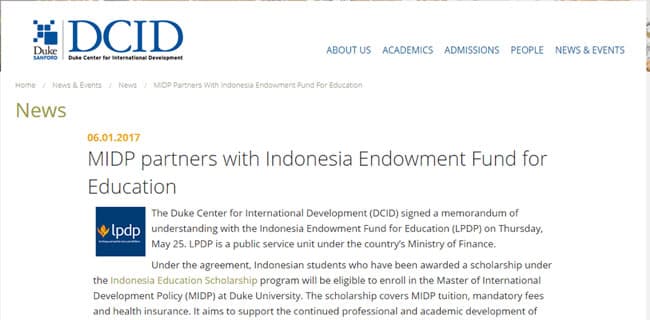Recruiting from Indonesia in a context of increased competition
Over the past six years, the number of Indonesian students studying abroad has grown by 21%: a very conservative UNESCO estimate is that 45,000 studied abroad in 2017, while other data suggests that this number was considerably higher.
Canada has been one beneficiary of the growth from this important source market, hosting 65% more Indonesians in 2018 than in 2014 and registering 40% more students in 2018 than in 2017. Still, there were only 1,970 Indonesian students in Canada in 2018 out of the tens of thousands abroad – and other leading English-speaking destinations that enrol larger numbers are seeing flat to declining growth from Indonesia.
For example:
- The number of Indonesians studying in Australia has held steady over the last few years, at roughly 16,500 per year.
- The US saw Indonesian student numbers fall from 8,775 to 8,650 from 2016/17 to 2017/18, a decrease of -1.4%.
- The number of Indonesians studying in the UK also fell – by 17% – from 3,630 in 2016/17 to 3,000 in 2017/18.
All this points to the fact that Indonesians are now considering a wider range of study abroad destinations, including Malaysia (10,400 in 2017), Japan (3,615), Germany (2,395), Egypt (2,185), and Saudi Arabia (1,715). Singapore and China are also actively recruiting Indonesians.
"China is welcoming these students with open arms," says a 2018 report in the South China Morning Post. "There are 14,000 Indonesians studying in China, according to government data. [In 2017], Beijing announced it had created 197 full scholarships for Indonesians who would like to pursue undergraduate and graduate degrees. In 2015, there were only 15 full scholarships set aside for Indonesians.”
Taiwan's Ministry of Education, meanwhile, reports that Indonesia is the fifth-largest sending market for Taiwan. There were nearly 5,000 Indonesians in Taiwan's universities in 2018, a total that has more than doubled over the last decade.
What does it take to establish a compelling presence in the fourth-most populous country on earth, a country whose market factors virtually guarantee that it will be one of the biggest senders of students abroad in the next decade? Ever more, the answer relies on understanding why Indonesians are increasingly considering destinations within Asia.
Market fundamentals are strong
More than 50% of Indonesians are under the age of 30, a huge youth demographic in this Muslim-majority country of 255 million people. Indonesia’s middle class is the largest in Southeast Asia and growing quickly, another key factor behind the trend of Indonesian students becoming more interested in – and able to – study abroad. The US Commercial Service estimates that 95% of Indonesian students abroad are self-funded.
Significant demand for quality education
There were approximately six million students in Indonesia’s higher education institutions in 2017, more than double the number in 2012. At the same time, gross enrolment in tertiary education in the country was only 36% in 2018, according to UNESCO. By comparison, the most recent World Bank data in this area shows that 42% of university-aged students are enrolled in tertiary education in Malaysia. Proportions rise further in Thailand (49%), China (51%), and especially South Korea (94%).
The Indonesian government is aware that it needs many more skilled workers and university graduates. Higher Education Marketing observes that degree holders compose just 7% of the Indonesian workforce. The World Bank has noted that this proportion will need to triple in order for the Indonesian labour market to grow enough to propel the country from its current position of 16th largest economy in the world to the top 10 – a jump experts believe is possible by 2030.
Currently, Indonesia has too few quality higher education institutions to meet domestic demand, despite the fact that the country has approximately 5,000 universities – almost double the number in China. Only the University of Indonesia made it into the Top 200 Times Higher Education Rankings for Asia (2019), compared with much higher numbers of universities ranking this highly in China, Japan, South Korea, Taiwan, and India. Singapore, meanwhile, has two universities in the Top 10 in Asia.
Expansion of vocational training
As in many emerging economies, vocational education providers (there are around 14,000 in total in the country) have gained newfound appeal given their focus on:
- Graduating students with practical skills that can quickly be applied to priority professions and sectors of the economy;
- Linkages with industry players in terms of shaping and delivering curriculum and providing internships and potential job opportunities.
There are opportunities for colleges and schools abroad to pursue partnerships and agreements with Indonesian vocational institutions and to promote their own vocational programmes in Indonesia.
The role of scholarships
The Indonesian government has recently more than doubled funding for the Indonesian Endowment Fund for Education (LPDP), a scholarship programme supporting Indonesian students going abroad for master’s and doctoral degrees.
Higher Education Marketing points to a webpage on the Duke University site as an example of good practice regarding making Indonesian students aware of LPDP scholarship opportunities.

The appeal of scholarships is strong among Indonesian students. While 95% of Indonesian students in foreign institutions may be self-funded, the number of Indonesians going abroad for studies could be much higher if more students were able to afford it. As we have noted previously,
“An AFS Intercultural Connections survey of Indonesian students aged 13–18 conducted in 2017 found that close to half (45%) would consider study abroad only if a full scholarship was available, and nearly a quarter (22%) said that once they had chosen a destination country, they would select the lowest tuition available for their studies. Some institutions recruiting in the Indonesian market are wisely setting up dedicated scholarship pages for Indonesian students.”
Community and affordability key
Indonesians are famous for the high value that they place on family and community – it’s one of the most important features of their culture. As a result, the relative closeness of major Asian destinations to Indonesia (i.e., home and family) and presence of some cultural similarities (e.g., Malaysia is also Muslim-majority) are expanding Indonesian students’ consideration sets (i.e., the group of school brands that they will consider applying to).
Proximity is not the only reason Indonesians are looking at Asian institutions. Affordability is a major draw. For example, the cost of studying for a year in China is US$1,700–3,100 for most programmes. In Taiwan it’s US$3,365–5,250 for most programmes. Fees in Japan and South Korea are slightly higher – US7,460–13,000 per year for undergraduate programmes in public universities – but they are still far lower than they are in leading English-speaking destinations. The average cost of studying for a degree programme for a year in Canada, the US, Australia, and the UK is at least US$20,000 and often much higher.
With Asian universities climbing fast into the top tiers of university world ranking systems, the cost discrepancies between Western and Eastern destinations are becoming a key reason that Indonesians – as well as other Asian students – are increasingly staying close to home.
Building the base
If your institution is considering increasing its Indonesian enrolments, it may want to consider a loss leader strategy to get the ball rolling, for example, a scholarship programme or price reduction for as many students as your budget will allow. If the budget simply won’t accommodate such a programme, a contest that centres on an opportunity to bring down the costs of studying can be another way of nudging enrolments along.
For example, Acadia University in Canada is relatively small (under 4,000 students, with a student to faculty ratio of 14:1). Its staff had done research showing that affordability was a major barrier for a sizeable proportion of prospective students, so they launched a “Win Your Room” campaign that gave entrants a chance at a free residence room for a year.

Beyond price discounting, it is absolutely essential to assure Indonesian students and parents that they will be welcome, find community, and be successful at your institution. Ideas include:
- Creating a webpage just for Indonesians: Create a dedicated webpage for Indonesian students and use it to customise essential information for them. How about having a video with a current Indonesian student explaining – in Bahasa Indonesia – how to apply for a visa? Or featuring a tour of the campus led by an Indonesian student? Profiles of successful Indonesian graduates are also great, especially if they highlight employment outcomes in a way that makes success feel attainable for Indonesian prospects.
Ideally, have a live chat function on your dedicated Indonesia webpage. A Facebook page is a definite must and an affordable way to show that your institution is serious about supporting its Indonesian student community. A nice bonus: the page will take on a life of its own, with students’ voices and comments often just as helpful (and authentic!) as anything your marketing team could say.

- Including parents in marketing communications: Parents need to be reassured that their children will be safe and happy at your institution. Include a “Parents’ Zone” on your dedicated Indonesia page, full of FAQs and testimonials.

The attention to parents should continue well after students are enrolled. A quarterly newsletter just for them is a great way to keep families involved.
- Committing seriously to student satisfaction: The best way to encourage more Indonesian prospects to enrol is to treat your current Indonesian students right. How are they doing with language and academic challenges? Are they making friends? Do they know how to get to a doctor, and do they feel confident enough in English to talk to that doctor about their symptoms? Do you have regular campus “mixer” events to help international and domestic students get to know each other?
If you provide a high quality of education and experience to your Indonesian students, these students will talk about it and take pictures and videos to send home. Give your satisfied crew every opportunity to share the fun they’re having – give them your school’s hashtags to attach to all the wonderful messages they’re sending home via Instagram and other social media platforms.
Competitive dynamics
As our focus on Indonesia demonstrates, we have entered a new era in terms of what it takes to recruit students from the most promising emerging markets. Knowing this, and adjusting strategies as a result, is the key to remaining relevant and attractive to students in these markets.
For additional background, please see:















